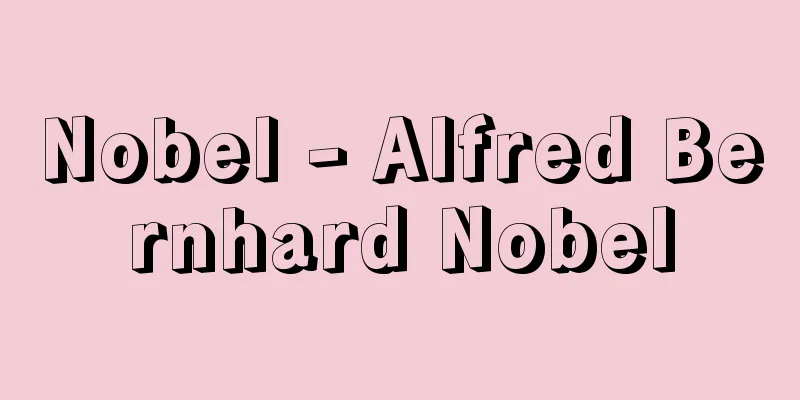Nobel - Alfred Bernhard Nobel

|
Swedish chemist, entrepreneur, and inventor of dynamite. Born in Stockholm, he attended elementary school in his hometown in 1841, but moved to St. Petersburg with his family in 1842, where he never received a formal education. In St. Petersburg, he received private lessons from chemist Zinin, who had drawn Nobel's attention to nitroglycerin. At the age of 17, he went to Sweden, Germany, France, Italy, and the United States for two years of study, where he learned chemistry, mechanics, and languages. During the Crimean War (1853-1856), he helped his father in his munitions factory, learning practical skills such as laying mines. In 1863, he returned to Stockholm and began research with his father on nitroglycerin, an alternative to black powder and guncotton. Nitroglycerin explodes when subjected to impact or friction, but does not explode simply by ignition like ordinary gunpowder. To use it as an explosive, it was necessary to develop a safe and reliable method of detonation. Nobel conducted more than 50 careful experiments in the laboratory he built in Heleneborg, and confirmed that in order for nitroglycerin to explode, the entire amount must be rapidly heated to its explosive temperature (170-180°C). In 1864, he succeeded in detonating a sealed container of nitroglycerin using a detonator, and obtained a patent for the so-called "detonator." The detonator at that time was black powder, but later mercury fulminate was used. In 1866, he began experiments with solids that could absorb nitroglycerin, which was difficult to handle as a liquid, in order to turn it into a solid form, and in 1867 he developed dynamite by soaking diatomaceous earth in nitroglycerin. During this time, the widespread use of nitroglycerin led to a series of explosions, resulting in many casualties, including the loss of Nobel's own brother in an accident, and sparking international controversy, but he continued to conduct scientific and systematic experiments. In 1876, he developed dynamite rubber, which had a greater explosive power, and in 1887, after more than 200 experiments, he developed the smokeless nitroglycerin gunpowder "Ballistite." Dynamite became a valuable energy source for railroads, civil engineering, and military technology during the period when Western countries, which had established industrial capital, were leaping toward imperialism. Dynamite factories were built in various countries, and in 1886, Nobel established the world's first international special company, the Nobel Dynamite Trust, which made him an enormous fortune. It is said that he loved peace and trusted the progress of science. He obtained 355 patents in various countries during his lifetime, covering a wide range of fields, and he called himself a citizen of the world. He lived in France in 1873 and in Italy from 1891, and died in San Remo in December 1896. His vast legacy was donated to the Stockholm Academy of Sciences for the spread of ideas of peace and the advancement of science, and the Nobel Prize was established. [Tomoko Takahashi] [References] | | | | |Source: Shogakukan Encyclopedia Nipponica About Encyclopedia Nipponica Information | Legend |
|
スウェーデンの化学者、企業家、ダイナマイトの発明者。ストックホルムに生まれ、1841年生地の小学校に入学、1842年家族とともにサンクト・ペテルブルグに移住、以後正規の教育を受けることはなかった。サンクト・ペテルブルグでは、ノーベルの関心をニトログリセリンに向けた化学者ジーニンらに個人教授を受けた。17歳でスウェーデン、ドイツ、フランス、イタリア、アメリカへ2年間の修業に出て、化学や機械学、語学を学んだ。クリミア戦争(1853~1856)の間は父の軍需工場を手伝い、機雷の敷設など実際的な技術を学んだ。1863年ストックホルムに戻り、黒色火薬や綿火薬にかわる、ニトログリセリンの研究を父とともに開始した。 ニトログリセリンは衝撃や摩擦で爆発するが、普通の火薬のように点火しただけでは爆発しない。これを爆薬に使うには安全で確実な爆発方法の開発が必要であった。ノーベルはヘレーネボルグに建てた実験所で50回を超える慎重な実験を行い、ニトログリセリンの爆発には全量を急激に爆発温度(170~180℃)に熱する必要があることを確かめた。1864年、密閉したニトログリセリンを起爆装置を使って爆発させることに成功、いわゆる「雷管」の特許を得た。このときの起爆剤は黒色火薬であったが、のちに雷酸水銀を使った。1866年、扱いにくい液体のニトログリセリンを固体状にするために、それを吸収させる固形物の実験を開始、1867年、珪藻土(けいそうど)にニトログリセリンをしみ込ませたダイナマイトを開発した。この間、ニトログリセリンの普及で爆発事故が相次ぎ、ノーベル自身弟を事故で失うなど多くの犠牲者が出て国際的物議を醸したが、彼は科学的、系統的な実験を繰り返した。1876年、より爆発力の大きいダイナマイトゴムを、1887年には200回以上の実験のすえ無煙ニトログリセリン火薬「バリスタイト」を開発した。 ダイナマイトは、産業資本を成立させた欧米諸国の帝国主義への飛躍の時代に、鉄道・土木ならびに軍事技術上の貴重なエネルギー源となった。各国にダイナマイト工場が建設され、1886年世界最初の国際的特殊会社「ノーベル・ダイナマイト・トラスト」を創設、ノーベルは巨万の富を得た。彼自身は平和を愛し、科学の進歩に信頼を寄せていたといわれる。彼が生涯に各国でとった355の特許は広い分野にわたり、世界市民を自称し、1873年フランスに、1891年からはイタリアに居を構え、1896年12月サン・レモで死去。その膨大な遺産は、平和思想の普及と科学進歩のためにとストックホルム科学アカデミーに寄贈され、ノーベル賞が設けられた。 [高橋智子] [参照項目] | | | | |出典 小学館 日本大百科全書(ニッポニカ)日本大百科全書(ニッポニカ)について 情報 | 凡例 |
Recommend
Infinite Embrace
A full-length novel by Takii Kosaku. Published by ...
Kollwitz, Käthe
Born: July 8, 1867, Königsberg [Died] April 22, 19...
Attribution
1. Attribution. Attribute. 2. Identifying the part...
Eun - Eun
?-1699 A monk from the early Edo period. He was a...
Battle of Mycale - Battle of Mycale
A battle in 479 BC during the Second Persian War. ...
Meishintanyu - Kukatachi
An ancient method of evidence. Mud was boiled in ...
Signal generator - signal generator
A signal generator is a device used as a signal so...
gay-coloured beetle
...About 3,000 species are known from around the ...
Fantômas (English spelling)
A French film. A serial action film produced from ...
Preservation measures - hozenshobun
In general, it refers to provisional measures ord...
Ansoff, HI - Ansoff
… [Diversification Strategy in the United States]...
Tomiai [town] - Tomiai
A former town in Shimomashiki County in central Ku...
Chinkai - Chinkai
A scholar of Sanron and painter-monk in the late ...
Carex breviculmis (English name)
…[Tetsuo Koyama]. … *Some of the terminology that...
Tripitaka Master Cimin (English: Tripitaka Master Cimin)
680‐748 A monk from the Tang Dynasty in China, and...





![Togane [city] - Tougane](/upload/images/67cc4dbf5b8a1.webp)



![Väner [Lake] - Väner](/upload/images/67ccca7445631.webp)